Slowakei |
|
|
|
| Übersicht – Contents: | |
Slowakei |
|
|
|
| Übersicht – Contents: | |
Flaggen – Flags: |
|
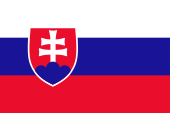 |
National- und Handelsflagge |
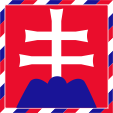 |
Flagge des Präsidenten |
historische Flaggen – historical Flags: |
|
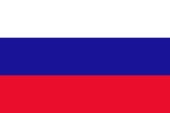 |
1848, 1939–1945, 1990–1993, |
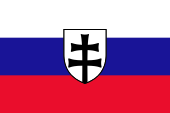 |
1939–1945, |
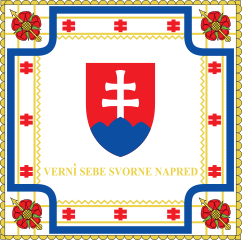 |
1939–1945, |
| Die heutige Flagge der Slowakei wurde am 01.01.1993 anlässlich der Unabhängigkeit eingeführt. Sie zeigt drei waagerechte Streifen in Weiß, Blau und Rot mit dem Staatswappen nahe dem Flaggenmast. Das Aussehen von Flagge und Wappen wurde im "Gesetz des Nationalrates der Slowakischen Republik über die nationalen Symbole der Slowakischen Republik und ihre Verwendung vom 18. Februar 1993" geregelt, jedoch ohne auf die Farbtöne einzugehen. Der farbige Abdruck im Gesetzblatt auf Seite 371 lässt vermuten, dass folgende Pantone-Farbtöne die Farbschattierungen korrekt wiedergeben könnten: Rot = Pantone 185, Blau = Pantone Reflex Blue. | The
today’s flag of Slovakia was introduced on the 1st of January in 1993 on the
occasion of the independence. It shows three horizontal stripes in white,
blue and red with the coat of arms near the flagpole. The appearance of the flag and coat of arms was regulated in the "Act of the National Council of the Slovak Republic on the National Symbols of the Slovak Republic and their Use of 18 February 1993", but without mentioning the colour shades. The colour print in the Law Gazette on page 371 suggests that the following Pantone shades could correctly reflect the colour shades: Red = Pantone 185, Blue = Pantone Reflex Blue. |
| Viele slawische Völker schufen sich in der Zeit nach 1848 (dem Jahr der Revolutionen) – im Zusammenhang mit einem erstarkenden slawischen Nationalismus – eigene Flaggen. Dabei spielte der Panslawismus eine bedeutende Rolle, eine politische Bewegung des 18./19. Jahrhunderts, die alle Slawen in einer Nation einen wollte. Die meisten slawischen Völker lebten jedoch in dieser Zeit unter österreichischer, türkischer oder auch deutscher Herrschaft. Der Panslawismus sah in Russland ein Vorbild, denn die Russen waren, neben Montenegro, die einzige freie slawische Nation. Und so wurden die Farben der russischen Flagge zum Idol der Panslawisten, und letztlich farbliches Vorbild bei der Gestaltung der Flaggen vieler slawischer Nationen. Diese Flaggen trugen und tragen bis auf wenige Ausnahmen die russischen Farben Weiß, Blau und Rot als gemeinsames Merkmal. Daher wird diese Farbkombination "Panslawische Farben" genannt. | Many
Slavic nations create on the 19th century own flags – in context with a
growing Slavic nationalism. Thereby played the Panslavism an important roll,
a political movement of the 18th/19th century, which would unite all Slavs
in one nation. The most Slavic nations however lived in this times under Austrian, Turkish or even German rule. The Panslavism saw in Russia a model, because the Russians were, apart from Montenegro, the only free Slavic nation. In this way the colours of the Russian flag became to an idol of the Panslavists, and in the end to a colour's pattern in the designing of the flags of many Slavic nations. Those flags carried and carry except few exceptions the Russian colours white, blue and red as mutual attribute. From there this colour's combination is named "Panslavic Colours". |
| Am 23.04.1848 nahmen die Slowaken zunächst eine weiß-rote Flagge an, die im August nach um die Farbe Blau ergänzt wurde (siehe weiter oben, Panslawische Farben). Die heutige Reihenfolge der Farben wurde im Jahre 1868 festgelegt. Offiziell wurde die Flagge jedoch nicht, da die Slowakei bis zum Friedensvertrag von Saint-Germain am 10.09.1919 ein Teil Ungarns war. danach wurde sie ein Bestandteil des Staates Tschechoslowakei. Erst im Jahre 1939 wurde unter deutschem Schutz die Slowakische Republik gegründet, die am 23.06.1939 die weiß-blau-rote Trikolore als Nationalflagge annahm. Zwischen 1945 und 1992 war die Slowakei vorübergehend wieder ein Teil der Tschechoslowakei. | On 23rd of April in 1848 the Slovaks first of all adoped a white-red flag, which was added in August by the colour blue (look above, Panslavic Colours). The today’s sequence of the colours was stipulated in the year 1868. The flag however became not officially, because Slovakia was a part of Hungary until the peace-treaty of Saint-Germain on the 10th of September in 1919. Thereafter Slovakia became a component of the state of Czechoslovakia. In the year 1939 was established – unger German protection - the Slovakian Republic which adoped on 23rd of June in 1939 the white-blue-red tricolour as national flag. Between 1945 and 1992 Slovakia was transitionally a part of Czechoslovakia again. |
| Nach dem Sturz der kommunistischen Herrschaft wurde am 01.03.1990 die weiß-blau-rote Trikolore wieder als Nationalflagge der Slowakei (noch immer föderaler Teilstaat der Tschechoslowakei) angenommen. | After the overthrow of the communist rule was adoped again on 1st of march in 1990 the white-blue-red tricolour as the national flag of Slovakia (still a federal partial state of Czechoslovakia). |
| Die Trikolore in den Farben Weiß, Blau und Rot entsprach jedoch der alten russischen Flagge die bis zum bolschewistischen Putsch durch Lenin (1917) und die darauf folgende Gründung von Sowjet-Russland (1918) verwendet wurde. Im Zusammenhang mit dem Untergang der Sowjetunion nahm Russland am 23.08.1991 wieder seine alte Trikolore an. | The
tricolour in the colours white, blue and red however correlated the old
Russian flag, which was in use until the bolshevist coup d’état by Lenin
(1917) and the following foundation of Soviet Russia (1918). In context with the collapse of the Soviet Union Russia adoped on 23rd of August in 1991 its old tricolour again. |
| Die Flagge der Slowakei glich nun derjenigen von Russland. Daher wurde im Zusammenhang mit der Verabschiedung der neuen Verfassung der unabhängigen Slowakei im September 1992 beschlossen, die Flagge ab dem 01.01.1993 um das Staatswappen zu ergänzen. | The flag of Slovakia equaled now the flag of Russia. Because of that was decided in context with the passing of the new constitution of the independent Slovakia in September 1992 to complete the flag since the 1st of January in 1993 by the coat of arms. |
| Quelle/Source: Flaggen und Wappen der Welt, Wikipedia (DE), Flags of the World, zákon o štátnych symboloch z 18. februára 1993, Volker Preuß | |
Wappen – Coat of Arms: |
|
 |
Wappen der Slowakei – coat of arms of Slovakia, Quelle/Source: zákon o štátnych symboloch z 18. februára 1993 |
| Das Staatswappen der Slowakei zeigt einen frühgotischen, abgerundeten Schild in Rot mit einem weißen Doppelkreuz auf einem blauen Dreiberg. Es geht auf das historische Wappen von Oberungarn zurück, und erinnert an die frühere Zugehörigkeit der Slowakei zum Königreich Ungarn. Der Dreiberg steht für die slowakischen Gebirge Tatra, Matra und Fatra. Ab 1848 wurde er in der Slowakei in Blau anstelle Grün dargestellt. Das byzantinische Doppelkreuz erinnert an die Christianisierung des Landes im 9. Jahrhundert und steht für die drei Heiligen Benedikt, Konstantin und Michael. | The coat
of arms of Slovakia shows an early gothic round shield in red with a white
twin-cross on a blue triple-mountain. It is derived from the historic coat
of arms of Upper Hungary and remembers to the earlier affiliation of
Slovakia to the Kingdom of Hungary. The triple-mountain stands for the Slovakian mountains Tatra, Matra and Fatra. Since 1848 in Slovakia it was coloured blue instead of green. The byzantinic twin-cross remembers the christianization of the country in the 9th century and stands for the three saints Benedict, Constantin and Michael. |
| Quelle/Source: Flaggen und Wappen der Welt, Wikipedia (DE), zákon o štátnych symboloch z 18. februára 1993, Volker Preuß | |
Flugzeugkokarde – aircraft roundel: |
|
 |
seit/since 1993, Flugzeugkokarde – aircraft roundel Quelle/Source, nach by: Wikipedia (EN) |
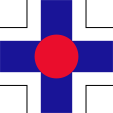 |
1940–1945, Flugzeugkokarde – aircraft roundel Quelle/Source, nach by: Wikipedia (EN) |
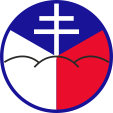 |
1944, Putschisten – Coup plotters, Flugzeugkokarde – aircraft roundel Quelle/Source, nach by: Wikipedia (EN) |
Landkarte – Map: |
Lage – Position: |
Landkarte des Landes – Map of the Country: |
| Zahlen und Fakten – Numbers and Facts: | |
|
|
|
|
|
|
|
|
|
|
|
|
|
|
|
|
|
|
|
|
| Antike ·
Besiedlung durch Kelten 300–200 v.Chr. · Besiedlung durch Sweben, Wandalen, Quaden, Markomannen und Langobarden 6. Jahrhundert · Besiedlung durch Slowaken, Abhängigkeit von den Awaren 8. Jahrhundert · Abhängigkeit vom Fränkischen Reich 9. Jahrhundert · zum Großmährischen Reich 10. Jahrhundert · Böhmen, Polen und Ungarn versuchen abwechselnd die Slowakei zu annektieren 1018 · die Slowakei wird ein Teil Ungarns, bleibt jedoch zunächst ein Teilfürstentum (tertia pars regni) 1321 · mit Matthäus von Trentschin stirbt der letzte slowakische Fürst 1687 · die Slowakei kommt mit Ungarn an das Haus Habsburg 10.09.1919 · Friedensvertrag von Saint-Germain, die Slowakei wird von Ungarn unabhängig, jedoch mit der Tschechei (Böhmen) zum Staat Tschechoslowakei zusammengeschlossen 01.09.1939 · Einmarsch deutscher und slowakischer Truppen in Polen (03.09. Frankreich und Großbritannien erklären dem Deutschen Reich den Krieg, Beginn des Zweiten Weltkriegs) 14.03.1939 · die Slowakische Volkspartei proklamiert unter Josef Tiso (1887–1947) die Slowakische Republik, Beitritt zum Drei-Mächte-Pakt (Achse) 1941–1945 · Beteiligung der Slowakei am Krieg des Deutschen Reiches gegen die Sowjetunion, 1944 Putsch von einem Drittel der slowakischen Armee gegen die Slowakische Volkspartei und deutsche Besatzungstruppen, 1945 Besetzung durch sowjetische Truppen Mai 1945 · Wiederherstellung der Tschechoslowakei als sozialistische Republik unter sowjetischen Einfluss 18.04.1947 · Hinrichtung von Josef Tiso 01.01.1969 · die Slowakei wird ein Föderativer Teilstaat (Slowakische Sozialistische Republik) innerhalb der Tschechoslowakischen Sozialistischen Republik (ÇSSR) 1989 · Sturz des kommunistischen Regimes in Prag, Unabhängigkeitsbestrebungen in der Slowakei 17.07.1992 · die Slowakei erklärt ihre Souveränität 02.09.1992 · Verfassung 01.01.1993 · Endgültige Trennung von der Tschechei, die Slowakei wird unabhängig 2004 · die Slowakei wird Mitglied der Europäischen Union 2009 · die Slowakei tritt der Euro-Zone bei |
| antiquity
· settlement by Celts 300–200 B.C. · settlement by Suebs, Vandals, Quads, Markomans and Langobards 6th century · settlement by Slovaks, dependence from the Awars 8th century · dependence from the Frankish Empire 9th century · to the Great Moravian Empire 10th century · Bohemia, Poland and Hungary try by turns to annex Slovakia 1018 · Slovakia becomes a part of Hungary but remains initially a partial principality (tertia pars regni) 1321 · with Mattheus of Trentshin dies the last Slovakian prince 1687 · Slovakia comes with Hungary to the Habsburg dynasty 10th of September 1919 · peace treaty of Saint-Germain, Slovakia becomes independent from Hungary, but becomes united with Czechia (Bohemia) to the State of Czechoslovakia 14th of March 1939 · the Slovak People's Party proclaims under Josef Tiso (1887–1947) the Slovakian Republic, joining to the Three-Mights-Pact (Axis) 1st of September 1939 · invasion of German and Slovak troops in Poland (3rd of September 1939 France and United Kingdom declare the war to the German Empire, onset of the Second World War) 1941–1945 · participation of Slovakia in the war of the German Empire against Soviet Union, 1944 coup of one third of the Slovak army aginst the Slovak People's Party and German occupation troops, 1945 occupation by soviet troops May 1945 · restoration of Czechoslovakia as socialistic republic under soviet influence 18th of April 1947 · execution of Josef Tiso 1st of January 1969 · Slovakia becomes a federative partial state (Slovakian Socialistic Republic) within the Czechoslovak Socialistic Republic (ÇSSR) 1989 · overthrow of the communist regime in Prague, ambitions for independence in Slovakia 17th of July 1992 · Slovakia declares its sovereignty 2nd of September 1992 · constitution 1st of January 1993 · ultimate separation from Czechia, Slovakia becomes independent 2004 · Slovakia becomes a member of the European Union 2009 · Slovakia joins the Euro Zone |
| Quelle/Source: Atlas zur Geschichte, Wikipedia (DE), World Statesmen |
| Der Name des Landes geht natürlich auf die Slowaken zurück, die wichtigste Volksgruppe des Landes. Das Wort "Slowak" geht auf das slawische Wort "slovit" zurück, was "sprechen" heißt. Die Slowaken sind also die "Sprechenden". Beachtenswert sind die Parallelen zu Slowenien, Slawonien und zu den "Slawen" überhaupt. | The name
of the country has its roots of course in the Slovaks, the most important
ethnic group of the country. The word "Slovak" is derived from the Slavic word "slovit", what means "speak". The Slovaks are in this way the "speaking". Noteworthy are the parallels to Slovenia, Slavonia and to the "Slavians" anyway. |
| Quelle/Source: Atlas der wahren Namen, Handbuch der geographischen Namen | |